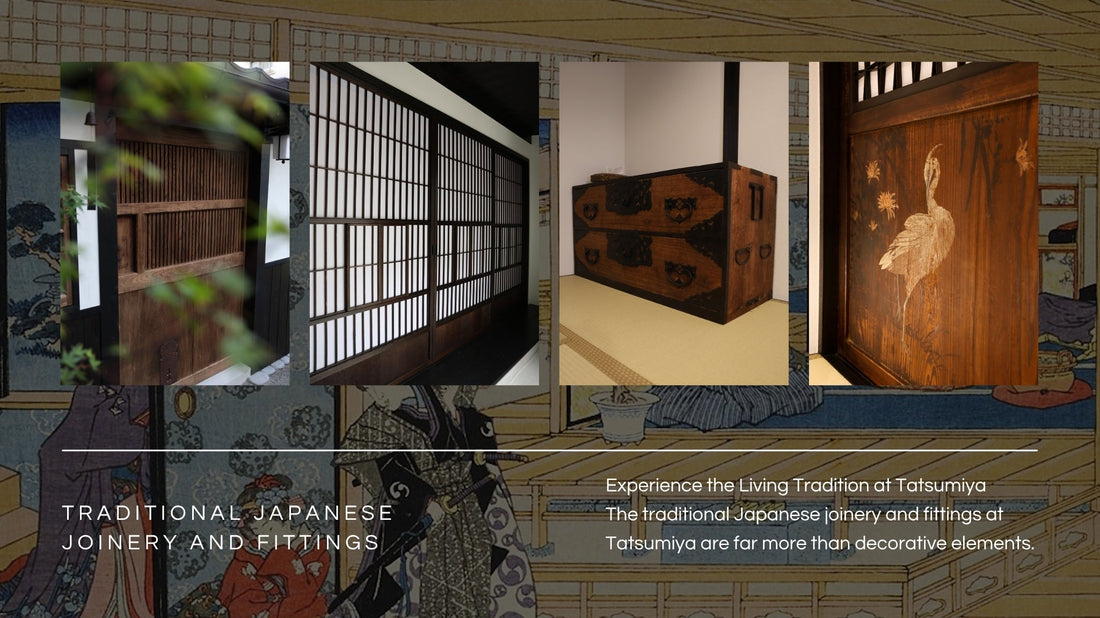
The Stories Behind Traditional Japanese Joinery and Fittings at Tatsumiya
Share
At Tatsumiya, we incorporate traditional Japanese joinery and fittings that evoke the atmosphere of Edo-period merchant culture.
Each piece reflects generations of craftsmanship and historical wisdom passed down through Japanese artisans.
In this article, we introduce the charm and roles of each fitting, along with real anecdotes from the Edo era.
----------
1. Kura Door – (Entrance)
In the Edo period, storehouses (kura) were vital for merchants and samurai to safeguard their wealth.
Thick wooden doors reinforced with iron hardware were used to protect against frequent fires and theft.
These kura doors, adorned with heavy iron fittings and locks, represented not only security but also the dignity and status of the household.

[Edo-Era Anecdote – The “Unopenable Door”]
At a long-established sake brewery, a kura door known as “the unopenable door” had been passed down for generations.
Though targeted by thieves multiple times, it was never breached thanks to its sturdy ironwork—proof of its reliability through the ages.

At Tatsumiya, this kura door is used as the entrance to the guesthouse.
The deep grain of the wood and the iron fittings offer an immediate sense of timeless gravitas and welcoming refinement.
Once a door for protecting wealth, it now begins a new chapter—as the door that welcomes guests.

----------
2. Nekomado Shoji – (Between Earthen Floor and Washitsu)
The nekomado shoji is a sliding paper door with a small openable window called a nekomado at the bottom.
This feature, developed during the Edo period, allowed cats to freely come and go while also improving ventilation.
Cats were considered lucky symbols of prosperity, especially in merchant towns like Osaka, making these fittings popular among successful shop owners.

[Edo-Era Anecdote –Legend from Osaka : The Cat That Brought Fortune]
At the famous kimono shop Echigoya (the origin of today’s Mitsukoshi), a white cat often sat at the storefront.
One day, the cat raised its paw as if beckoning. A passing samurai noticed, stepped inside, and made a large purchase.
The story spread quickly: “The Echigoya cat calls in customers.”
The shopkeeper then installed a Nekoma shōji so the cat could come and go freely.
From then on, cats were celebrated as symbols of prosperity.

At Tatsumiya, this fitting connects the earthen floor (doma) with the washitsu (tatami room).
Soft light filters through the paper, and gentle breezes pass through the nekomado, evoking a nostalgic warmth and playful Edo charm.

----------
3. Sado Tansu – (Washitsu)
Sado Tansu is a robust and elegant chest of drawers made by skilled artisans on Sado Island during the Edo period.
Adorned with elaborate iron hardware, these chests were used to protect valuables and were often given as bridal gifts in prestigious families.
Especially in the Ogi region of Sado, these pieces were rare and painstakingly handcrafted. They served as symbols of household prestige and wealth.

[Edo-Era Anecdote – A Statement of Status]
In the late Edo period, a noblewoman brought a Sado Tansu with her as part of her dowry. The iron fittings bore her family crest.
In merchant households, some families would even deliberately display the delivery of a Sado Tansu in public to convey their high status to the town.

At Tatsumiya, this chest is placed in the washitsu, adding quiet dignity and a sense of story to the space.
It invites guests to experience the aesthetic values and formal beauty cherished by Edo-period families.

----------
4. Painted Wooden Door – (Between Hallway and Washitsu)
These painted wooden doors were used in the back rooms of merchant and samurai houses.
Unlike simple fusuma, they featured refined paintings of seasonal motifs like flowers, birds, wind, and moon—collectively known as "kachō fūgetsu", an embodiment of Japanese beauty.

What is Kacho Fugetsu?
An expression of appreciation for the beauty of nature, representing:
Ka (Flowers) – Seasonal blossoms such as cherry or chrysanthemum
Cho (Birds) – Graceful figures like cranes and bush warblers
Fū (Wind) – Breezes that suggest the changing seasons
Getsu (Moon) – The serene glow of the moon in night skies
During the Edo period, to incorporate such nature-inspired motifs into one’s home was considered refined and cultured.

[Edo-Era Anecdote – A Canvas of Prestige]
One wealthy merchant in Osaka invited a Kano school painter to decorate a wooden door with pine trees and cranes as a gift for a new house.
This raised the prestige of the guest room and reflected the family's refined taste.

At Tatsumiya, this type of painted door is used between the hallway and the washitsu.
Walking through it feels like stepping into a living scroll—an immersive encounter with traditional aesthetics.

----------
5. Muso Door – (Closet for Futon Storage)
A musō door is a sliding panel that can be opened from either side, enhancing space efficiency—a clever invention from the Edo period.
Often used for closets and storage, this structure blends practicality and beauty in tight living spaces.
Designed for breathability, it was especially suited to Japan's humid climate.

[Edo-Era Anecdote – Hidden Function, Hidden Grace]
At a traditional pharmacy, musō doors were used to hide records and tools, quickly accessible but out of sight—embracing the idea of “unseen elegance.”

At Tatsumiya, this fitting is used for futon storage.
It smoothly integrates into daily life while embodying Edo-period values of simplicity, efficiency, and grace.
----------
6. Masugoshi Itado – (Toilet)
This wooden lattice door with backing boards blocks views from the outside while allowing air and light to pass through.
Known as masugōshi itado, it was used by merchants who preferred privacy and sophistication over showing off their interiors.
The repeated lattice pattern offers visual rhythm, ventilation, and dignity.

[Edo-Era Anecdote – Hidden Prestige]
At a kimono merchant's shop in Osaka, the lattice was designed to make the interior invisible from certain angles, reflecting refined hospitality and security.
The subtle spacing and finishes showcased the skill of the craftsmen and the pride of the shop.

At Tatsumiya, this masugōshi door is used for the toilet area, providing privacy while maintaining harmony with the traditional aesthetic.
A seamless blend of functionality and beauty.
----------
7. Full Lattice Door – (Washbasin Area)
In Edo-period merchant houses, full lattice doors allowed air to flow while obscuring views from outside.
Paired with features like mushikomado (fine lattice windows), they helped cool interiors during hot summers.

[Edo-Era Anecdote – A Sound Trap for Thieves]
In one merchant house, thin wire was added to the lattice, making a sound when disturbed—an ingenious burglar deterrent.
This shows how townspeople creatively worked with limited materials to ensure safety.

At Tatsumiya, this door is used for the washbasin area, providing airflow and privacy while creating a beautiful interplay of light and shadow.
It's a space where traditional wisdom enhances everyday comfort.
----------
Experience the Living Tradition at Tatsumiya
The traditional Japanese joinery and fittings at Tatsumiya are far more than decorative elements.
Each piece carries the legacy of Edo-period life, craftsmanship, and cultural wisdom.
Only by seeing, touching, and using them can one truly understand their weight and meaning.
These fittings, passed down through generations, seem to speak softly of the people and lives they once served.
A stay at Tatsumiya is a journey back in time—
An invitation to experience the spirit of Edo with all five senses.

















![Top 10 Hidden Tourist Spots In Osaka Prefecture [Secret Gem Edition] - Wecreate Japan](http://wecreatejapan.com/cdn/shop/articles/1c50642b3d5819b7eda31a68c07248ed.jpg?v=1745556661&width=170)
![Top 20 Popular Tourist Spots In Osaka Prefecture [Definitive Edition] - Wecreate Japan](http://wecreatejapan.com/cdn/shop/articles/a3a727e16b502b4f5d4ac7dffb5bed3d.jpg?v=1745556662&width=170)